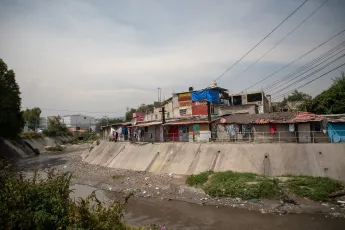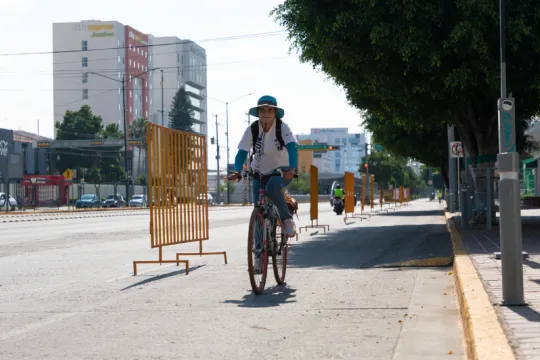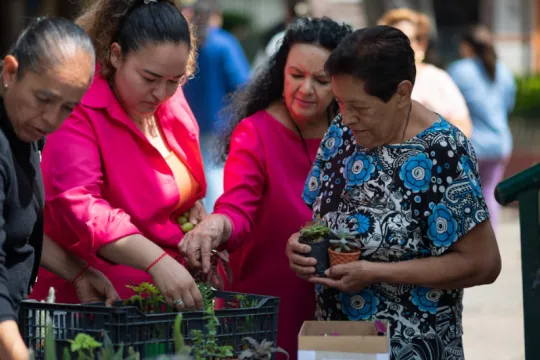
Informal settlements on a riverside
by Mariana Campos and Acoyani Adame
The prevailing model for how we make cities does not help us move towards fair cities with net zero carbon emissions. Cities represent a great opportunity to face the climate crisis, as they are the areas in which 70% of CO2 emissions are generated. However, the response has been slow and ineffective given the dimension of the problem, acknowledges the sixth IPCC report. In addition, inequality has not been integrated as a structural cause that increases the fragility of cities against the effects of climate change, while limiting their capacity to respond.
The IPCC report as well as various research reports agree that top-down planning and governance models are insufficient to reduce greenhouse gas (GHG) emissions generated in urban environments because they are based on sectoral, fairly uncollaborative planning processes that propose isolated solutions that are hardly contextualized to the needs and dynamics at the local level. When decision-making does not include the perspective and participation of all social sectors, there is no comprehensive response to the challenge involving the implementation of climate change mitigation or adaptation measures in cities, which generates resistance to the proposed policies and projects and increases urban inequality gaps.
Bottom-up processes as alternatives to the current model
There is consensus around the need for change in governance and transition towards more collaborative and innovative models, and bottom-up urban planning is recognized as a model that tackles the issues of poverty and inequality while enabling progress towards cities that are resilient to climate change.
Participatory urban planning is conceived as a key aspect for urban sustainability, as the presence of citizen participation not only in the identification of problems, but in the solutions and decisions about the future of their urban environments leads to the creation of better solutions, supported by the communities and various sectors involved. Citizen participation in a top-down planning process ultimately becomes the exercise of the collective right to transform the city.
In turn, this bottom-up participatory urban planning model makes it possible to respond to the urban inequalities present in the region, which, as Susan Fainstein points out in Ciudad Justa, are perpetuated by the prevailing models of how cities are made today - the post-industrial models of modern urbanism.
It is also agreed that solid institutional frameworks are required to ensure continuity in citizen participation processes, so that the responses defined in the processes can be scaled up and supported by guaranteed sources of financing and other resources. Citizen participation should be a process and not an end in itself, as Arnstein points out in her ladder of citizen participation.
Adequate answers already exist and can be used as a guide to this process.
The latest IPCC report recognizes that the decarbonization of cities must translate into a fair process of transformation in which the inequalities present in the cities are addressed, and the Climate Resilient Development (CRD) model is proposed for this purpose. This model is based on inclusive, multi-actor, equitable and fair governance systems that recognize that solutions to social and economic challenges will be more effective through inclusive and participatory planning built upon the pillars of health, equity, well-being and justice. In this vein, the proposal of a Climate Compatible Development assumes that participatory dialogue processes are effective and essential for the development process.
Urban labs as an alternative for participatory planning
Urban labs have become an increasingly popular practice to meet this demand. According to ongoing research conducted as part of the Transformative Urban Coalitions (TUC) project, urban labs emerged in the 1990s in European cities to streamline and modernize government processes and public services, and have since been adopted in different regions as part of participatory planning and public policy approaches in the world.
Although there is no single definition for urban labs, and they are known by different terms, it is generally agreed that they are spaces focused on people’s needs, that use innovative and experimental approaches to accelerate decision-making processes and find more relevant solutions to complex urban challenges. Their work is guided by a search for consensus, collaborative diagnoses, co-creation processes and demonstration activities around specific problems in delimited territories. An intrinsic characteristic of urban laboratories is the horizontal participation of stakeholders from all sectors: government, civil society and the academic and private sectors.
There is no recipe for implementing an urban lab; however, the Urban Living Lab of the Amsterdam Institute for Advanced Metropolitan Solutions defines eight steps that can serve as examples, which include: problem definition; identification of key actors from different sectors; project definition, elaboration of a work plan and establishment of a common vision; monitoring of the creative co-design process; implementation of the experimental proposal; assessment, adjustment, communication and documentation of the lessons learned; and, finally, replication of the actions in other areas of the city.
Currently, there are 66 labs in operation in 13 Latin American countries, with successful and effective responses. These spaces operate with different formats. Some are institutionalized within the government structure, with assigned resources and teams, and operate as participatory and innovation branches. Others are generated by civil society initiatives or are part of academic programs at universities and research institutes.
The first institutionalized lab in Latin America emerged in 2013 in Mexico City - the Laboratorio para la Ciudad, a lab within the government structure that ceased to operate after the change in administration. It was the experimental and creative arm of Mexico City’s government and sought to explore new ways of approaching and imagining the city based on six areas of research and action.
Some examples of citizen urban labs are the Ciudad Laboratorio or Ciudadlab, in Caracas, Venezuela, a civil association that promotes reflection, research and urban transformation, with the capacity to articulate efforts with various actors; the Vivero de Iniciativas Ciudadanas, a space to support the transition of cities to more resilient environments through citizen participation, and the Laboratorio de Cambio Social Cambiarnos in Santiago, Chile, whose work methodology is based on participatory action and research and urban governance towards sustainability.
Some of the lessons learned from the labs in the region indicate that placing citizen participation at the heart of the process is an effective way to ensure that the generated solutions respond to the actual demands of the population, leading to a better adoption of the results, the promotion of transformative changes in urban governance and the permanence of ideas regardless of changes in administration. Finally, citizen participation strengthens relationships between the municipal government, academia, communities and the private sector, as it establishes networks between different areas and actors who do not usually dialogue.
However, certain challenges for the implementation and success of citizen participation models are also pointed out, specifically the issue of permanence. This underscores the importance of a solid institutional framework that allows innovation and guarantees its continuity through earmarked resources.
The urban labs of the Transformative Urban Coalitions project
The Transformative Urban Coalitions (TUC) project aims to explore and promote new governance models to accelerate climate action, and is currently focused on Latin America with the installation of five urban labs in Argentina, Brazil and Mexico, working on the generation of a community of practice, exchange of experiences and strengthening of capacities, as well as transformative research that allows the identification of good practices and facilitates the replicability of effective governance models.
In Mexico, during the first half of 2022, two urban labs were installed: one in León, Guanajuato, and another in Naucalpan, State of Mexico. To date, four meetings have been held in each city, with an average attendance of 32 people from different sectors. During these meetings, a decalogue of participation has been built collaboratively, problems and opportunities diagnosed and identified through participatory digital and physical mapping, and work areas defined in both cities. Field visits have also been carried out to identify transformation opportunities on the ground, and work is currently underway to reach agreement on a shared vision with a 2030 horizon.
The identification and connection of actors to the urban labs is a continuous process. The next sessions held by the labs will focus on the definition of an action plan, potential demonstration activities and a work plan for next year.
There is a common understanding of the need to change the way in which decisions have been made and the design of climate and social policies, as climate change gives rise to a social and environmental crisis that calls for coordinated multisectoral and transdisciplinary action supported by bottom-up processes.
The lessons learned in the region indicate that urban labs have the potential to accelerate climate action in urban environments by enabling solutions that integrate the vision and proposals of all sectors into the cities’ decision-making processes, and by promoting urban transformations that are more relevant to local needs.
The Transformative Urban Coalitions project promotes citizen participation models in an urban lab format to create more resilient and equitable cities. The urban labs implemented in the five selected cities and the analysis of the participatory planning and governance processes that are generated at these locations will allow, in addition to promoting transformation in those cities, the identification of best practices and replication of these models in other Latin American cities.
This article was originally published on WRI Mexico’s website. See original article in Spanish.

